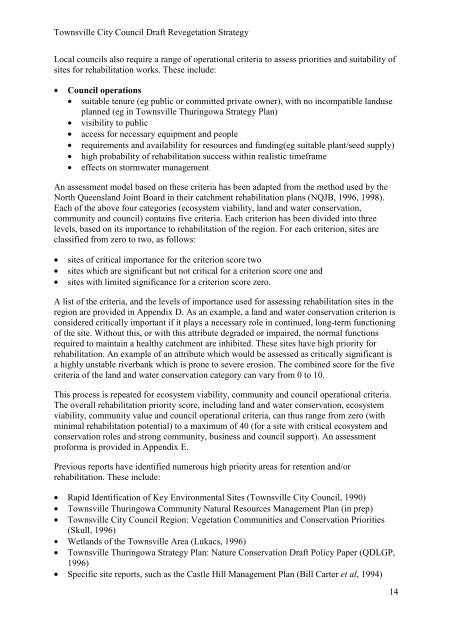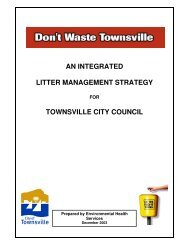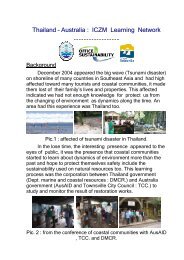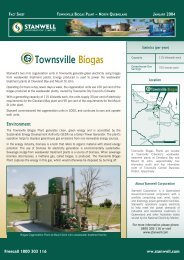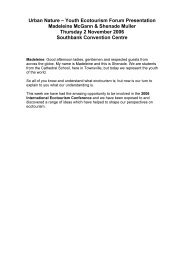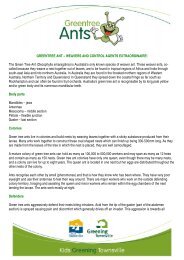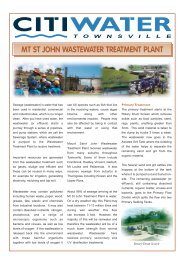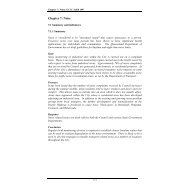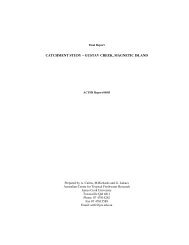Revegetation Strategy - Townsville State of the Environment Report
Revegetation Strategy - Townsville State of the Environment Report
Revegetation Strategy - Townsville State of the Environment Report
Create successful ePaper yourself
Turn your PDF publications into a flip-book with our unique Google optimized e-Paper software.
<strong>Townsville</strong> City Council Draft <strong>Revegetation</strong> <strong>Strategy</strong><br />
Local councils also require a range <strong>of</strong> operational criteria to assess priorities and suitability <strong>of</strong><br />
sites for rehabilitation works. These include:<br />
• Council operations<br />
• suitable tenure (eg public or committed private owner), with no incompatible landuse<br />
planned (eg in <strong>Townsville</strong> Thuringowa <strong>Strategy</strong> Plan)<br />
• visibility to public<br />
• access for necessary equipment and people<br />
• requirements and availability for resources and funding(eg suitable plant/seed supply)<br />
• high probability <strong>of</strong> rehabilitation success within realistic timeframe<br />
• effects on stormwater management<br />
An assessment model based on <strong>the</strong>se criteria has been adapted from <strong>the</strong> method used by <strong>the</strong><br />
North Queensland Joint Board in <strong>the</strong>ir catchment rehabilitation plans (NQJB, 1996, 1998).<br />
Each <strong>of</strong> <strong>the</strong> above four categories (ecosystem viability, land and water conservation,<br />
community and council) contains five criteria. Each criterion has been divided into three<br />
levels, based on its importance to rehabilitation <strong>of</strong> <strong>the</strong> region. For each criterion, sites are<br />
classified from zero to two, as follows:<br />
• sites <strong>of</strong> critical importance for <strong>the</strong> criterion score two<br />
• sites which are significant but not critical for a criterion score one and<br />
• sites with limited significance for a criterion score zero.<br />
A list <strong>of</strong> <strong>the</strong> criteria, and <strong>the</strong> levels <strong>of</strong> importance used for assessing rehabilitation sites in <strong>the</strong><br />
region are provided in Appendix D. As an example, a land and water conservation criterion is<br />
considered critically important if it plays a necessary role in continued, long-term functioning<br />
<strong>of</strong> <strong>the</strong> site. Without this, or with this attribute degraded or impaired, <strong>the</strong> normal functions<br />
required to maintain a healthy catchment are inhibited. These sites have high priority for<br />
rehabilitation. An example <strong>of</strong> an attribute which would be assessed as critically significant is<br />
a highly unstable riverbank which is prone to severe erosion. The combined score for <strong>the</strong> five<br />
criteria <strong>of</strong> <strong>the</strong> land and water conservation category can vary from 0 to 10.<br />
This process is repeated for ecosystem viability, community and council operational criteria.<br />
The overall rehabilitation priority score, including land and water conservation, ecosystem<br />
viability, community value and council operational criteria, can thus range from zero (with<br />
minimal rehabilitation potential) to a maximum <strong>of</strong> 40 (for a site with critical ecosystem and<br />
conservation roles and strong community, business and council support). An assessment<br />
pr<strong>of</strong>orma is provided in Appendix E.<br />
Previous reports have identified numerous high priority areas for retention and/or<br />
rehabilitation. These include:<br />
• Rapid Identification <strong>of</strong> Key <strong>Environment</strong>al Sites (<strong>Townsville</strong> City Council, 1990)<br />
• <strong>Townsville</strong> Thuringowa Community Natural Resources Management Plan (in prep)<br />
• <strong>Townsville</strong> City Council Region: Vegetation Communities and Conservation Priorities<br />
(Skull, 1996)<br />
• Wetlands <strong>of</strong> <strong>the</strong> <strong>Townsville</strong> Area (Lukacs, 1996)<br />
• <strong>Townsville</strong> Thuringowa <strong>Strategy</strong> Plan: Nature Conservation Draft Policy Paper (QDLGP,<br />
1996)<br />
• Specific site reports, such as <strong>the</strong> Castle Hill Management Plan (Bill Carter et al, 1994)<br />
14


